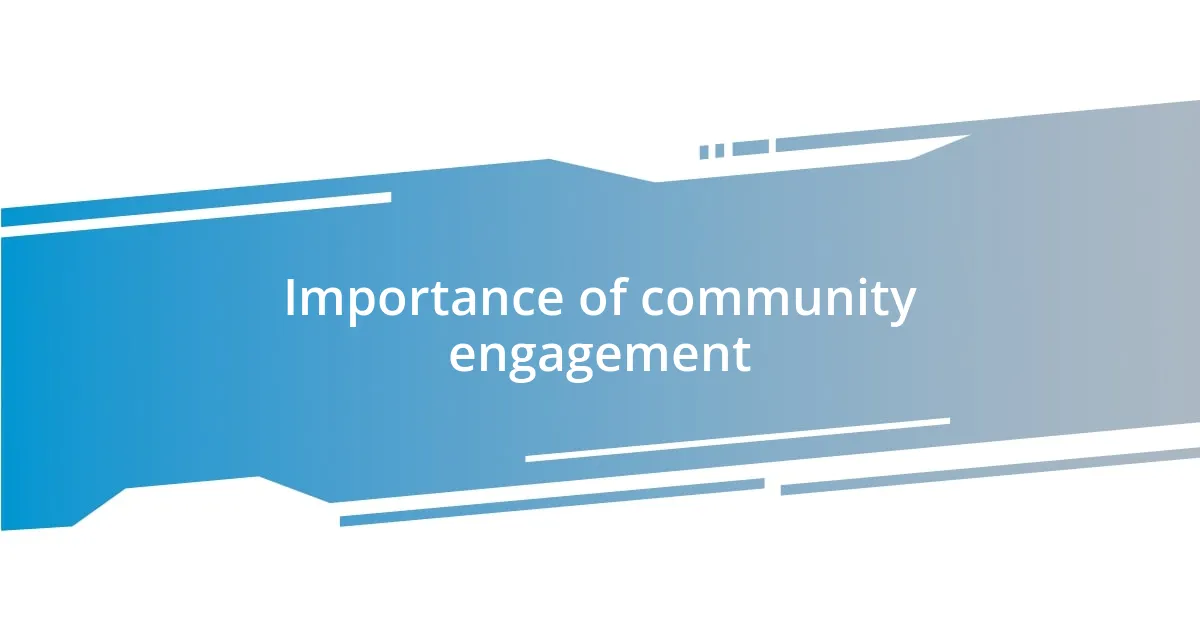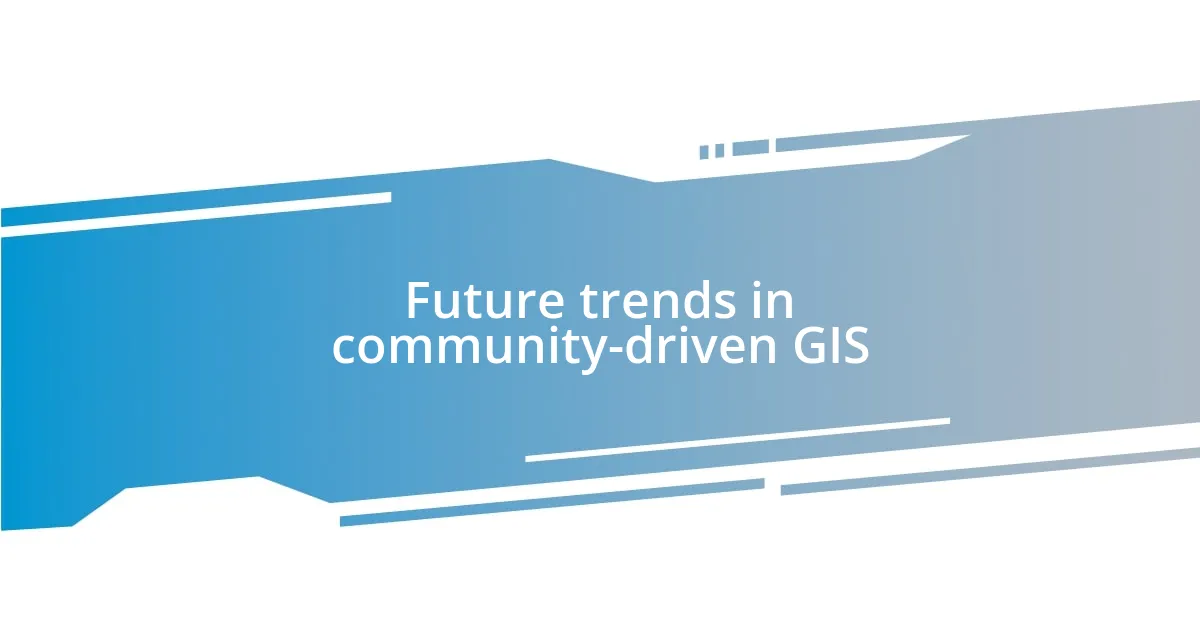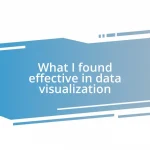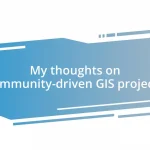Key takeaways:
- Community-driven GIS projects leverage local knowledge, enhancing data collection and fostering community engagement.
- Successful initiatives demonstrate empowerment: residents use GIS to address issues like beach erosion and healthcare access, leading to impactful local solutions.
- Inclusive participation and accessible training are vital for effective community involvement in GIS projects.
- Emerging trends include mobile data collection and partnerships with academic institutions, enhancing collaboration and innovation within communities.

Understanding community-driven GIS projects
Community-driven GIS projects reflect the incredible power of collaboration within local populations. When I participated in a neighborhood mapping initiative, I was struck by how diverse perspectives can enrich data collection and interpretation. It made me wonder: How often do we overlook the valuable insights that community members hold when making decisions about their own environments?
These projects often emerge from a genuine need for local solutions, harnessing the unique knowledge that residents possess about their surroundings. I remember a particularly impactful moment when a resident pointed out an area prone to flooding that hadn’t been documented in official surveys. It was a stark reminder of how important it is to include the voices of those directly impacted by geographic changes—who better to inform us than the people living it daily?
What truly fascinates me about community-driven GIS is the level of engagement it spurs. It’s not just about mapping; it’s about fostering a sense of ownership and responsibility among residents in shaping their spaces. I find myself reflecting on the countless stories shared during those sessions, each one adding depth to the data. How can we tap into this wealth of local knowledge to create more effective and resilient communities?

Importance of community engagement
Engaging the community in GIS projects is crucial for generating meaningful and relevant outcomes. When I’ve been part of such initiatives, I noticed that every participant brought unique experiences that colored the discussion. For instance, during one mapping session, a participant related their encounter with unauthorized dumping in their neighborhood. This story was more than just a data point; it became a catalyst for action. It highlighted the vital role local stories play in shaping an accurate representation of the community’s issues.
Here are some key reasons why community engagement is essential in GIS projects:
- Local Expertise: Community members possess intimate knowledge of the area’s geography, culture, and history.
- Enhanced Trust: Building connections fosters trust between residents and project leaders, encouraging open dialogue.
- Diverse Perspectives: A variety of backgrounds contribute to richer data, leading to well-rounded solutions.
- Empowerment: Involving residents gives them a sense of agency over local issues, boosting morale and collaboration.
- Improved Sustainability: Solutions informed by community insights are more likely to be sustainable in the long run.
Reflecting on these experiences, I often see first-hand the palpable difference that deep engagement can make. Each shared story transforms not only the map but also the people involved, creating a vibrant tapestry of community spirit and resilience.

Success stories in community GIS
Success stories in community GIS highlight how empowered locals can steer projects that resonate deeply with their needs. One such project that stands out to me was in a small coastal town where residents utilized GIS to address beach erosion. They mapped the shoreline over time and combined their observations with historical data to visualize changes. Witnessing a community rally around this issue was exhilarating—seeing how their shared love for their hometown led to actionable solutions inspired me.
Another impactful story came from a rural area where a community identified the lack of access to healthcare facilities. By collaboratively mapping out resources like doctors’ offices, transportation options, and potential sites for new clinics, they created a visual representation that attracted attention from local policymakers. I remember feeling a wave of optimism as residents shared these maps in town hall meetings, sparking conversations that ultimately led to new healthcare initiatives. It became clear that their voices, when amplified through GIS, generated not just awareness but real change.
Lastly, one project I closely observed involved urban gardening initiatives in a city fraught with food deserts. Community members meticulously mapped vacant lots that could be transformed into gardens. The engagement during these workshops was palpable; people shared their dreams of fresh produce and community gatherings. I still recall the enthusiasm in the air when they collectively visualized a greener future. This project not only cultivated plants but also brought the community closer, reinforcing the idea that GIS can not only chart a physical space, but also weave together the social fabric of a neighborhood.
| Project | Key Outcome |
|---|---|
| Coastal Erosion Mapping | Community-driven solutions for beach preservation |
| Healthcare Access Mapping | Increased awareness leading to new health initiatives |
| Urban Gardening Initiatives | Enhanced community bonding and access to fresh produce |

Tools for collaborative GIS projects
When it comes to collaborative GIS projects, the right tools can truly make a difference. For example, I’ve found that platforms like ArcGIS Online allow users to share maps and data seamlessly. This feature creates an environment where individuals can easily upload their findings and engage in meaningful discussions about the data they’re collecting. I remember a particularly engaging session where we all gathered around a shared map, debating the best routes for a proposed trail based on both data and local stories.
Another tool I often turn to is OpenStreetMap, which excels in fostering collaboration by allowing community members to contribute their local knowledge directly. The beauty of OpenStreetMap lies in its open-source nature; anyone can edit and add to the map. Once during a project, I collaborated with a group wherein we updated our neighborhood’s mapper—each contribution sparked lively conversations about what else needed visibility. I still cherish those moments, knowing that each edit was not just a data point but a connection among us.
Finally, I want to highlight StoryMapJS, which combines storytelling with GIS. This tool resonates deeply with me because it allows users to present geographic information in a narrative format, blending maps with personal anecdotes. I recall using it for a community storytelling initiative, capturing residents’ experiences in a way that engaged both hearts and minds. Who doesn’t love a story? When we paired our mapping efforts with personal narratives, it became clear how effective this method was at building community pride and broadening understanding of our local issues.

Strategies for effective participation
When engaging communities in GIS projects, one key strategy is to ensure inclusivity. I recall a project where we gathered a diverse group of participants, from students to elders, in a workshop to map local resources. The energy in the room was electric! Each person brought unique perspectives, and it struck me how vital it is to include all voices to capture a complete picture of community needs. Have you ever noticed how different backgrounds shape our understanding of a place? That blending of experiences often leads to richer, more impactful outcomes.
Moreover, providing clear, accessible training is essential for fostering effective participation. In one initiative I facilitated, we organized a series of informal learning sessions, guiding participants through the basics of GIS tools. Faced with new technology, some were initially hesitant. But by creating a supportive environment where curiosity was encouraged, I witnessed their confidence blossom. Watching someone go from apprehension to excitement transformed my belief in the value of hands-on learning. Isn’t it amazing how empowerment can flourish when knowledge is shared openly?
Another effective strategy is to break down complex projects into manageable tasks. I remember a community team tackling a large environmental mapping project. Instead of overwhelming the group with the entire scope, we divided it into smaller, focused segments. Each participant took ownership of specific areas. This approach not only alleviated stress but also built a sense of pride and responsibility. I often found myself reflecting on how these small wins can motivate continued engagement. Have you ever experienced the satisfaction of seeing a project come together piece by piece? It’s that journey of collaboration that truly solidifies community bonds.

Overcoming challenges in community GIS
Finding ways to engage the community and overcome challenges in GIS can be daunting. I remember a project where we faced significant skepticism from some locals about the value of mapping their area. By organizing a series of informal meet-ups and actively listening to their concerns, I was able to build trust. It’s fascinating how simply showing that you care about people’s thoughts can shift their perspective and transform them into enthusiastic contributors.
Another challenge often encountered is the technical barrier that some community members might feel. I once worked with a group where the older participants were intimidated by the technology. To address this, we paired tech-savvy individuals with those needing support in a buddy system. Watching them bond over shared learning moments, laughter, and the occasional frustration reinforced my belief that patience and understanding are essential ingredients in community-driven projects. Isn’t it amazing how overcoming such barriers leads to powerful connections?
Resources can also be scarce, which poses a challenge for community GIS projects. During a mapping initiative in my neighborhood, we struggled with limited funding and materials. Instead of giving up, we reached out to local businesses who were excited to sponsor our project in exchange for visibility. This not only ensured we had the necessary tools but also fostered a sense of ownership within the community. Have you ever seen how collective effort can turn constraints into creative solutions? It’s a testament to the strength and resilience found within local networks.

Future trends in community-driven GIS
It’s intriguing to consider how technology is reshaping community-driven GIS projects. In my experience, there’s been a noticeable shift towards integrating real-time data collection through mobile applications. I participated in a project where community members used their smartphones to document environmental changes. The immediacy of this approach not only empowered individuals but also created a vibrant tapestry of data that reflected real-world dynamics. Have you ever thought how much richer a community’s narrative can become when everyone is a contributor?
As we look ahead, the potential for collaboration with academic institutions and tech companies seems immense. I recall collaborating with university students in a GIS project; their fresh insights and energetic enthusiasm breathed new life into our work. This kind of partnerships could become a treasure trove of resources, merging innovative ideas with local knowledge. Isn’t it exciting to think about the possibilities when expert guidance meets grassroots wisdom?
Finally, we can’t ignore the growing embrace of open data principles. In my journey, I’ve seen communities take charge of their GIS projects by advocating for transparency and accessibility. A neighborhood initiative I was part of made all data public, inviting anyone to dive in, analyze, and build upon it. This not only fostered trust but also sparked community-led efforts to innovate and improve the original project. Can you imagine how a community’s identity can evolve when it collectively harnesses and shares its information? It feels like we’re just scratching the surface of what’s possible.












